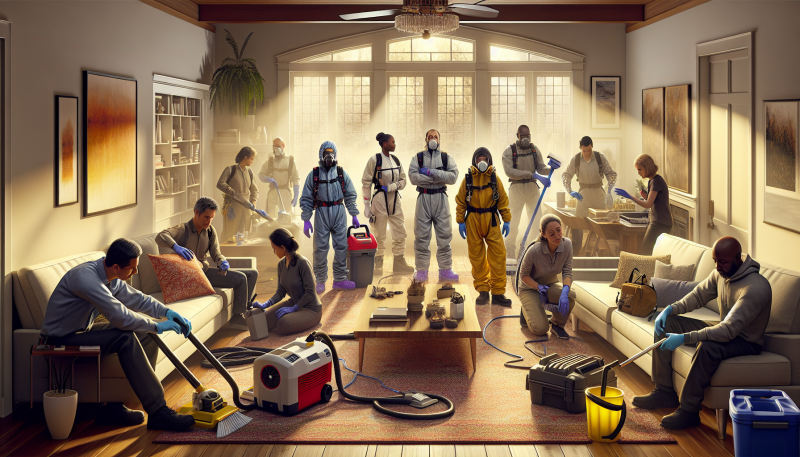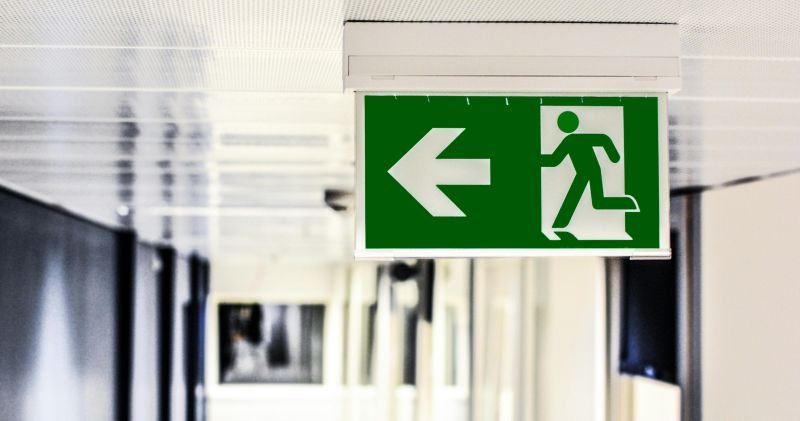Post-restoration inspections play a vital role in ensuring the success of any restoration project, particularly after incidents involving water or fire damage. These inspections are essential for assessing the effectiveness of the restoration process and identifying any lingering issues that may compromise the safety and integrity of your property. At COMMITTED TO QUALITY SERVICE, we understand that thorough post-restoration inspections not only help in verifying that all damage has been addressed but also provide peace of mind to property owners. Our team is dedicated to delivering fast, friendly, and professional service, ensuring that every aspect of your restoration is meticulously evaluated. Whether you’ve experienced water damage that requires specialized drying equipment or fire damage that needs careful mitigation, our comprehensive inspections will help safeguard your home or business. Trust us to guide you through the restoration journey and ensure that your property is restored to its pre-damage condition. Call us now at 855-933-7935 to learn more about our services and the importance of post-restoration inspections!
Understanding Post-Restoration Inspections
Post-restoration inspections are a critical component of the restoration process following damage from events such as floods, fires, or mold infestations. These inspections serve as a comprehensive evaluation of the restoration work completed, ensuring that the property is not only aesthetically restored but also structurally sound and safe for occupancy. Understanding the nuances of post-restoration inspections can significantly impact the long-term health of a property and the well-being of its occupants.
The primary goal of a post-restoration inspection is to verify that all restoration efforts have been executed to the highest standards. This includes checking for any signs of lingering damage, ensuring that all affected areas have been properly treated, and confirming that the restoration meets local building codes and regulations. A thorough inspection can help identify potential issues that may not be immediately visible, such as hidden water damage or structural weaknesses, which could lead to more significant problems in the future.
One of the key aspects of post-restoration inspections is the assessment of moisture levels. According to the Environmental Protection Agency (EPA), moisture control is essential in preventing mold growth, which can pose serious health risks. Inspectors use specialized tools to measure moisture levels in walls, floors, and other surfaces to ensure that they are within acceptable limits. If elevated moisture levels are detected, further remediation may be necessary to prevent mold and other issues from developing.
In addition to moisture assessment, post-restoration inspections also involve a detailed examination of the work completed. This includes checking the quality of repairs, the effectiveness of water extraction, and the thoroughness of cleaning processes. For instance, in the case of fire damage, inspectors will look for signs of soot and smoke residue that may have been overlooked during the restoration process. Ensuring that all traces of damage have been addressed is crucial for the safety and comfort of the occupants.
Furthermore, post-restoration inspections provide an opportunity for property owners to ask questions and express any concerns they may have about the restoration work. This open line of communication between the restoration team and the property owner is vital for building trust and ensuring that the restoration meets the owner’s expectations. It also allows for any necessary adjustments to be made before the project is officially completed.
The importance of documentation cannot be overstated in post-restoration inspections. Inspectors typically provide a detailed report that outlines their findings, including photographs and descriptions of any issues identified. This documentation serves as a valuable record for property owners, insurance companies, and future buyers. It can also be instrumental in resolving any disputes that may arise regarding the quality of the restoration work.
In conclusion, post-restoration inspections are an essential step in the restoration process that should not be overlooked. They ensure that the property is safe, structurally sound, and free from hidden damage. By investing in a thorough inspection, property owners can protect their investment and provide a safe environment for occupants. As the saying goes, "An ounce of prevention is worth a pound of cure." By prioritizing post-restoration inspections, property owners can prevent future issues and ensure the longevity of their restored spaces.
For more information on the restoration process, you can visit our about page or explore our services to see how we can assist you. If you are dealing with specific issues like water damage or fire damage, our team is here to help. Remember, thorough inspections and proper restoration are key to maintaining a safe and healthy living environment.
Key Benefits of Conducting Inspections
Conducting inspections after restoration is a crucial step that brings numerous benefits to property owners and restoration professionals alike. One of the primary advantages of post-restoration inspections is the assurance of quality and thoroughness in the restoration process. These inspections help verify that all necessary repairs have been completed to a high standard, ensuring that the property is safe and habitable. By identifying any remaining issues or potential problems, property owners can address them promptly, preventing further damage and costly repairs in the future.
Another significant benefit of conducting inspections is the peace of mind it provides. Knowing that a qualified professional has thoroughly evaluated the property can alleviate concerns about hidden damages or lingering hazards. This is particularly important in cases of water damage, fire damage, or mold remediation, where the risks of secondary damage or health issues can be substantial. Inspections can uncover hidden problems that may not be immediately visible, such as moisture trapped behind walls or structural weaknesses, allowing for timely intervention.
Additionally, post-restoration inspections can enhance the overall value of a property. A well-documented inspection report can serve as a valuable asset when selling a home or property. Potential buyers are often more inclined to invest in a property that has been thoroughly inspected and restored, knowing that it has been cared for and is less likely to present unforeseen issues. This documentation can also be beneficial for insurance purposes, providing evidence of the restoration work completed and the current condition of the property.
Furthermore, conducting inspections can help in maintaining compliance with local building codes and regulations. Restoration projects often require adherence to specific standards, and inspections ensure that all work meets these requirements. This not only protects the property owner but also contributes to the safety and integrity of the community as a whole.
In the context of insurance claims, post-restoration inspections can play a vital role. They provide documentation that can support claims for damages and repairs, ensuring that property owners receive the compensation they are entitled to. This can be particularly important in complex cases involving extensive damage, where clear evidence of the restoration work completed is necessary for a successful claim.
Lastly, regular inspections can foster a proactive approach to property maintenance. By establishing a routine of inspections, property owners can identify and address minor issues before they escalate into major problems. This preventive strategy not only saves money in the long run but also extends the lifespan of the property and its components.
In conclusion, the key benefits of conducting post-restoration inspections encompass quality assurance, peace of mind, increased property value, compliance with regulations, support for insurance claims, and proactive maintenance. These inspections are an essential part of the restoration process, ensuring that properties are safe, functional, and ready for occupancy. For more information on how to effectively manage restoration projects, visit our about page or explore our services to understand the comprehensive solutions we offer. If you are dealing with specific issues like water damage or fire damage, our expert team is here to assist you.
Common Issues Identified During Inspections
Post-restoration inspections play a crucial role in ensuring that a property is safe, secure, and restored to its original condition after experiencing damage from incidents such as water, fire, or mold. During these inspections, professionals assess the effectiveness of the restoration work and identify any lingering issues that may not have been addressed. Common issues identified during these inspections can vary widely depending on the type of damage that occurred, but there are several recurring problems that restoration experts frequently encounter.
One of the most prevalent issues is inadequate drying after water damage. Even after visible water has been removed, moisture can remain trapped in walls, floors, and other materials. This hidden moisture can lead to mold growth, structural damage, and health risks for occupants. Inspectors often use specialized equipment to detect moisture levels in various materials, ensuring that all areas have been thoroughly dried. If moisture is detected, further remediation may be necessary to prevent future complications.
Another common issue is the presence of mold, which can develop rapidly in damp environments. Even if the initial water damage has been addressed, mold spores can linger and begin to grow if conditions remain favorable. During inspections, professionals look for signs of mold growth, such as discoloration, musty odors, and visible spores. If mold is found, it is essential to implement proper mold remediation procedures to eliminate the problem and prevent it from returning.
Fire damage inspections often reveal issues related to smoke and soot residue. Even after a fire has been extinguished, smoke particles can permeate walls, furniture, and other surfaces, leading to lingering odors and potential health hazards. Inspectors assess the extent of smoke damage and recommend appropriate cleaning and restoration methods to ensure that all residues are removed. Failure to address smoke damage can result in long-term issues, including persistent odors and compromised indoor air quality.
In addition to these specific issues, inspectors also evaluate the overall structural integrity of the property. This includes checking for signs of warping, cracking, or other damage that may have occurred during the restoration process. Structural issues can pose significant risks to safety and may require additional repairs to ensure that the property is safe for occupancy. Inspectors often collaborate with structural engineers to assess any concerns and develop a plan for necessary repairs.
Another area of concern during post-restoration inspections is the quality of the repairs made. Restoration work must meet specific standards to ensure that it is durable and effective. Inspectors evaluate the workmanship of repairs, checking for proper installation of materials and adherence to industry standards. If any deficiencies are identified, they must be addressed promptly to avoid future problems.
Additionally, inspectors often look for signs of pest infestations that may have developed during the restoration process. Water damage can attract pests such as termites or rodents, which can cause further damage to the property. Identifying and addressing pest issues is essential to maintaining the integrity of the restoration work and ensuring a safe living environment.
Finally, the effectiveness of any preventive measures taken during the restoration process is assessed. This includes evaluating the installation of vapor barriers, drainage systems, and other protective measures designed to prevent future damage. Inspectors ensure that these systems are functioning correctly and that the property is adequately protected against potential future incidents.
In conclusion, post-restoration inspections are vital for identifying common issues that may arise after a property has undergone restoration. From hidden moisture and mold growth to smoke damage and structural integrity, these inspections help ensure that all aspects of the restoration have been addressed. By identifying and resolving these issues early, property owners can protect their investments and maintain a safe and healthy living environment. For more information about our services and how we can assist with your restoration needs, visit our services page or learn more about our mission.
The Role of Professionals in Post-Restoration Inspections
Post-restoration inspections are a critical phase in the restoration process, ensuring that properties are returned to their pre-damage condition and that all necessary repairs have been completed effectively. The involvement of professionals in this stage cannot be overstated, as their expertise and experience play a vital role in guaranteeing the quality and safety of the restoration work. Professionals, such as certified restoration specialists, engineers, and inspectors, bring a wealth of knowledge to the table, allowing them to identify potential issues that may not be visible to the untrained eye. Their training equips them to assess the structural integrity of a building, check for hidden water damage, and ensure that all safety standards are met.
One of the primary responsibilities of these professionals during post-restoration inspections is to conduct thorough evaluations of the work completed. This includes checking for proper drying and dehumidification after water damage, ensuring that fire damage repairs have restored the property to a safe condition, and verifying that mold remediation has been effectively carried out. Their assessments help to prevent future problems, such as mold growth or structural failures, which can arise from inadequate restoration efforts. By utilizing advanced tools and techniques, professionals can detect moisture levels and potential hazards that might otherwise go unnoticed.
Moreover, professionals are adept at interpreting building codes and regulations, ensuring that all restoration work complies with local laws. This compliance is crucial not only for the safety of the occupants but also for the property owner’s peace of mind. A thorough inspection by a qualified professional can help avoid legal issues that may arise from non-compliance, which could lead to costly fines or additional repairs down the line. Their knowledge of industry standards also means they can provide valuable recommendations for future maintenance, helping property owners protect their investments.
In addition to technical assessments, professionals play a significant role in documentation and reporting. They provide detailed reports that outline the condition of the property post-restoration, including any areas of concern that need to be addressed. This documentation is essential for insurance claims, as it provides evidence of the restoration work completed and any ongoing issues that may require attention. Furthermore, these reports can serve as a reference for future inspections or maintenance, ensuring that property owners have a clear understanding of their property’s condition over time.
The emotional aspect of restoration cannot be overlooked either. Property owners often feel overwhelmed and stressed after experiencing damage to their homes or businesses. Professionals not only bring technical expertise but also offer reassurance and guidance throughout the inspection process. Their ability to communicate effectively with property owners helps to alleviate concerns and build trust, making the entire experience less daunting. By explaining the inspection process and the findings in layman’s terms, professionals empower property owners to make informed decisions about their properties.
In conclusion, the role of professionals in post-restoration inspections is multifaceted and essential for ensuring the success of the restoration process. Their expertise in evaluating the quality of work, ensuring compliance with regulations, providing thorough documentation, and offering emotional support makes them invaluable to property owners. Engaging qualified professionals not only enhances the safety and integrity of the restored property but also contributes to the overall satisfaction of the property owner. For those seeking to understand more about the restoration process, including the importance of inspections, exploring resources on our mission and services can provide further insights into how to navigate post-restoration challenges effectively.
How Inspections Enhance Safety and Compliance
Post-restoration inspections play a crucial role in ensuring safety and compliance in various environments, particularly after incidents such as water damage, fire damage, or mold remediation. These inspections are not merely a formality; they are an essential step in the restoration process that helps to verify that all restoration work has been completed to the highest standards. By conducting thorough inspections, property owners and restoration professionals can identify any potential hazards that may have arisen during the restoration process, ensuring that the environment is safe for occupants.
One of the primary benefits of post-restoration inspections is the enhancement of safety. After a property has undergone restoration, there may be lingering issues that could pose risks to health and safety. For instance, in the case of water damage, hidden moisture can lead to mold growth, which can have serious health implications for occupants. A comprehensive inspection can help identify any areas where moisture may still be present, allowing for timely remediation before it becomes a larger issue. Similarly, after fire damage, structural integrity must be assessed to ensure that the building is safe to occupy. Inspections can uncover hidden damage that may not be immediately visible, such as compromised beams or walls, which could lead to dangerous situations if left unaddressed.
Compliance with local regulations and industry standards is another critical aspect of post-restoration inspections. Many jurisdictions have specific codes and standards that must be adhered to when restoring properties after damage. Inspections help ensure that all work performed meets these requirements, thereby protecting property owners from potential legal issues or fines. By verifying that restoration work complies with applicable regulations, property owners can have peace of mind knowing that their property is not only safe but also legally compliant.
Moreover, inspections can serve as a valuable tool for documentation. In the event of future claims or disputes, having a detailed inspection report can provide evidence that the property was restored properly and safely. This documentation can be crucial for insurance purposes, as it demonstrates that the property owner took the necessary steps to ensure safety and compliance after a damaging event. It can also be beneficial when selling a property, as potential buyers will appreciate knowing that the property has been thoroughly inspected and is safe for occupancy.
In addition to safety and compliance, post-restoration inspections can also enhance the overall quality of the restoration work. By conducting a thorough review of the completed work, restoration professionals can identify any areas that may require additional attention or correction. This not only ensures that the property is restored to its original condition but can also improve the longevity of the repairs made. For example, if an inspection reveals that certain materials were not installed correctly, addressing these issues promptly can prevent future problems and additional costs down the line.
Furthermore, inspections foster a culture of accountability among restoration professionals. Knowing that their work will be subject to scrutiny encourages contractors to adhere to best practices and maintain high standards throughout the restoration process. This accountability can lead to better outcomes for property owners, as they can trust that the work performed is of the highest quality.
In conclusion, post-restoration inspections are a vital component of the restoration process that significantly enhances safety and compliance. By identifying potential hazards, ensuring adherence to regulations, providing documentation, improving the quality of work, and fostering accountability, inspections contribute to a safer and more compliant environment for all occupants. Property owners should prioritize these inspections as part of their restoration efforts to ensure that their properties are not only restored but are also safe and compliant with all relevant standards. For more information on our services and how we can assist you in the restoration process, please visit our services page. If you have experienced water damage and need guidance on how to address it, check out our article on how to identify hidden water damage early. For any inquiries or to schedule an inspection, feel free to contact us.
The Impact of Inspections on Property Value
Post-restoration inspections play a crucial role in determining the value of a property, particularly after it has undergone significant repairs or restoration due to damage from events such as water, fire, or mold. These inspections serve as a comprehensive assessment of the property’s condition, ensuring that all restoration work has been completed to a high standard and that the property is safe and habitable. When potential buyers or investors evaluate a property, they often look for assurance that any previous damage has been properly addressed. A thorough inspection can provide this assurance, thereby positively influencing the property’s market value.
One of the primary ways inspections impact property value is through the verification of quality restoration work. When a property has been restored after damage, it is essential that the repairs meet industry standards. An inspection can confirm that all necessary repairs have been made and that the property is structurally sound. This verification can alleviate concerns for potential buyers, making them more likely to invest in the property. In contrast, if an inspection reveals subpar work or unresolved issues, it can lead to a decrease in property value as buyers may perceive the property as a financial risk.
Additionally, inspections can uncover hidden issues that may not be immediately visible. For instance, water damage can lead to mold growth, which can compromise both the structural integrity of the property and the health of its occupants. A post-restoration inspection can identify these hidden problems, allowing for timely remediation. Addressing these issues before they escalate not only protects the property but also enhances its value. Buyers are more inclined to pay a premium for a property that has been thoroughly inspected and is free from hidden dangers.
Moreover, the presence of a detailed inspection report can serve as a valuable marketing tool. When selling a property, having a recent inspection report can instill confidence in potential buyers. It demonstrates transparency and a commitment to maintaining the property’s condition. This can lead to a quicker sale and potentially a higher selling price. Buyers are often willing to pay more for a property that has been professionally inspected and restored, as it reduces their risk and provides peace of mind.
In the realm of real estate, the perception of value is often influenced by the condition of the property. Properties that have undergone restoration without proper inspections may carry a stigma, leading to lower offers from buyers. Conversely, properties that have been inspected and certified as safe and well-maintained can command higher prices. This is particularly true in competitive markets where buyers have numerous options. A property that stands out due to its verified condition can attract more interest and potentially lead to bidding wars, further driving up its value.
Furthermore, inspections can also impact insurance premiums and financing options. Insurance companies often require proof of restoration and inspections before providing coverage. A property that has undergone thorough inspections may qualify for lower insurance rates, making it more attractive to buyers. Similarly, lenders may be more willing to finance a property that has been inspected and deemed safe, as it reduces their risk. This can open up the market to a broader range of potential buyers, ultimately enhancing the property’s value.
In conclusion, the impact of inspections on property value cannot be overstated. They provide essential verification of restoration quality, uncover hidden issues, and serve as a powerful marketing tool. Properties that have undergone thorough inspections are more likely to attract buyers, command higher prices, and enjoy favorable financing and insurance terms. For homeowners and investors alike, understanding the importance of post-restoration inspections is vital in maximizing property value. To learn more about how inspections can affect your property, visit our about page or explore our services to see how we can assist you in maintaining your property’s value. If you are facing issues related to water, fire, or mold damage, our water damage restoration services can help ensure your property is restored to its best condition.
Best Practices for Conducting Post-Restoration Inspections
Post-restoration inspections are a critical component of the restoration process, ensuring that properties are returned to their pre-damage condition and that all necessary repairs have been completed effectively. Conducting these inspections requires a systematic approach to guarantee that no detail is overlooked. Here are some best practices to follow when performing post-restoration inspections.
First and foremost, it is essential to establish a comprehensive checklist before beginning the inspection. This checklist should cover all areas affected by the damage, including structural components, electrical systems, plumbing, and any finishes or furnishings that were impacted. By having a detailed list, inspectors can systematically evaluate each area, ensuring that nothing is missed. This checklist can also serve as a valuable reference for future inspections or for clients who may want to understand the scope of the restoration work completed.
Next, it is crucial to involve qualified professionals in the inspection process. Restoration experts, such as those specializing in water damage, fire damage, or mold remediation, bring a wealth of knowledge and experience to the table. Their expertise allows them to identify potential issues that may not be immediately apparent to the untrained eye. Additionally, having a team of professionals can facilitate a more thorough inspection, as different specialists can focus on their areas of expertise.
During the inspection, it is important to document everything meticulously. Taking photographs and notes can provide a clear record of the condition of the property before and after restoration. This documentation is not only useful for the property owner but can also serve as evidence in case of disputes or insurance claims. Furthermore, detailed records can help in evaluating the effectiveness of the restoration efforts and in planning future maintenance.
Another best practice is to conduct a thorough assessment of the air quality and moisture levels in the property. After water damage, for example, hidden moisture can lead to mold growth and other issues that may not be visible on the surface. Utilizing moisture meters and air quality testing can help identify any lingering problems that need to be addressed. This step is particularly important in areas that are prone to mold, as it ensures that the environment is safe for occupants.
Communication with the property owner is also a vital aspect of the post-restoration inspection process. Keeping the owner informed about the findings and any necessary follow-up actions fosters trust and transparency. It is beneficial to explain the inspection process, the results, and any recommendations in a clear and understandable manner. This approach not only helps the owner feel more involved but also empowers them to make informed decisions regarding their property.
Finally, it is essential to follow up after the inspection. This may involve scheduling additional repairs, conducting further testing, or simply checking in with the property owner to ensure that everything is functioning as it should. A proactive approach to follow-up can prevent minor issues from escalating into major problems, ultimately saving time and money for both the restoration team and the property owner.
In conclusion, conducting post-restoration inspections is a crucial step in the restoration process. By following these best practices, including creating a comprehensive checklist, involving qualified professionals, documenting findings, assessing air quality and moisture levels, communicating effectively with property owners, and ensuring thorough follow-up, restoration teams can ensure that properties are restored to their optimal condition. This diligence not only enhances the quality of the restoration work but also contributes to the overall satisfaction of the property owner. For more information on the importance of restoration services, visit our about page or explore our blog for insights and tips on maintaining a safe and healthy environment after restoration.
Frequency and Timing of Inspections
Post-restoration inspections are a critical component of the restoration process, ensuring that properties are returned to a safe and habitable condition after incidents such as water damage, fire damage, or mold infestations. The frequency and timing of these inspections play a vital role in maintaining the integrity of the restoration work and safeguarding the health of occupants. Regular inspections help identify any lingering issues that may not have been apparent immediately after the restoration was completed.
Typically, the first inspection occurs shortly after the restoration work is finished. This initial assessment is crucial for verifying that all repairs have been completed to the required standards and that the property is safe for occupancy. During this inspection, restoration professionals will check for any signs of residual damage, moisture, or mold growth that could pose health risks. It is essential to conduct this inspection promptly to address any issues before they escalate, which could lead to further damage and increased repair costs.
Following the initial inspection, it is advisable to schedule follow-up inspections at regular intervals. These inspections can be conducted monthly for the first few months after restoration, transitioning to quarterly inspections as time goes on. The frequency of these inspections may vary depending on the type of restoration work performed and the specific conditions of the property. For example, properties that have experienced significant water damage may require more frequent inspections to monitor for hidden moisture that could lead to mold growth. In contrast, properties that have undergone fire damage may need inspections focused on structural integrity and air quality.
Timing is also crucial when it comes to inspections. Seasonal changes can impact the condition of a property, especially in areas prone to heavy rainfall or extreme temperatures. Scheduling inspections before and after significant weather events can help identify potential vulnerabilities and ensure that the property remains in good condition. Additionally, if occupants notice any unusual odors, discoloration, or other signs of potential problems, it is essential to conduct an inspection immediately, regardless of the regular schedule.
In addition to routine inspections, it is important to consider the long-term maintenance of the property. Homeowners and property managers should be proactive in monitoring their properties for any signs of damage or deterioration. This includes being vigilant about potential water leaks, checking for cracks in walls or foundations, and ensuring that ventilation systems are functioning properly. Regular maintenance can help prevent the need for extensive restoration work in the future and can be an integral part of a comprehensive property management strategy.
For those who have recently undergone restoration, understanding the importance of ongoing inspections cannot be overstated. It is not just about ensuring that the restoration was done correctly; it is also about protecting the health and safety of everyone who occupies the space. Mold spores, for example, can remain dormant for long periods and may become active again under the right conditions. Regular inspections can help catch these issues early, allowing for timely remediation and preventing more significant health risks.
In conclusion, the frequency and timing of post-restoration inspections are essential for ensuring that properties remain safe and free from hidden dangers. By conducting thorough inspections shortly after restoration and continuing with regular follow-ups, property owners can protect their investments and the well-being of their occupants. For more information on the importance of inspections and how to maintain a safe living environment, visit our about page or explore our services to learn more about our comprehensive restoration solutions. Additionally, if you are concerned about potential water damage, check out our guide on how to identify hidden water damage early to stay informed and proactive.
Documenting Inspection Findings
Documenting inspection findings is a critical component of the post-restoration process, serving as a comprehensive record that ensures transparency, accountability, and effective communication among all stakeholders involved. After a restoration project, whether it involves water damage, fire damage, or mold remediation, it is essential to conduct thorough inspections to assess the effectiveness of the restoration efforts. This documentation not only captures the current state of the property but also provides valuable insights into any remaining issues that need to be addressed.
The process of documenting inspection findings begins with a detailed assessment of the property. Inspectors should utilize checklists that cover all critical areas, including structural integrity, moisture levels, air quality, and any signs of lingering damage. Photographic evidence is also crucial; taking before and after pictures can visually demonstrate the success of the restoration and highlight any areas that may require further attention. This visual documentation can be particularly persuasive when communicating with property owners, insurance companies, or regulatory bodies.
In addition to photographs, written reports should accompany the documentation. These reports should include a summary of the inspection process, findings, and recommendations for any additional work that may be necessary. Clear and concise language is essential to ensure that all parties can easily understand the findings. The reports should also reference any applicable standards or guidelines that were followed during the inspection, reinforcing the credibility of the findings.
Furthermore, documenting inspection findings is not just about recording what has been done; it also plays a vital role in future planning. By maintaining a comprehensive record of inspections, restoration companies can identify patterns or recurring issues that may indicate underlying problems. This historical data can inform future restoration efforts and help in developing proactive strategies to prevent similar issues from arising.
Effective documentation also enhances communication with clients. Providing clients with a detailed account of the inspection findings fosters trust and confidence in the restoration process. Clients are more likely to feel satisfied with the work done when they can see documented evidence of the thoroughness of the inspections and the effectiveness of the restoration efforts. This transparency can lead to positive reviews and referrals, which are invaluable for any restoration business.
In conclusion, documenting inspection findings is an indispensable part of the post-restoration process. It ensures that all aspects of the restoration are thoroughly evaluated and recorded, providing a clear picture of the property’s condition. This documentation not only aids in effective communication with clients and stakeholders but also serves as a valuable resource for future restoration projects. By prioritizing meticulous documentation, restoration professionals can enhance their service quality and contribute to the overall success of their projects. For more information about our services and how we can assist you, visit our services page or check out our about section to learn more about our mission and values.
Case Studies: Success Stories from Inspections
Post-restoration inspections play a crucial role in ensuring that properties are returned to their pre-damage condition after incidents such as water damage, fire damage, or mold infestations. These inspections not only verify the effectiveness of the restoration work but also provide peace of mind to property owners. Through a series of case studies, we can illustrate the significant impact that thorough post-restoration inspections have had on various properties and their owners.
One notable case involved a residential property that suffered extensive water damage due to a burst pipe. After the initial restoration process, which included water extraction and drying, a post-restoration inspection was conducted. The inspection revealed hidden pockets of moisture behind the walls that were not adequately addressed during the initial restoration. By identifying these issues early, the restoration team was able to implement additional drying measures and prevent the growth of mold, which could have led to serious health concerns for the family living in the home. This case highlights the importance of comprehensive inspections in identifying potential problems that could arise after the restoration process.
Another success story comes from a commercial building that experienced fire damage. Following the restoration, a post-restoration inspection was performed to assess the structural integrity of the building and ensure that all fire-damaged materials were properly removed and replaced. During the inspection, the team discovered that some areas had not been fully cleaned of soot and smoke residue, which could have posed health risks to the occupants. The restoration team promptly addressed these issues, ensuring that the building was safe for reoccupation. This case underscores how post-restoration inspections can safeguard the health and safety of individuals who will use the space.
In a different scenario, a property that had undergone mold remediation was subjected to a post-restoration inspection to confirm the effectiveness of the treatment. The inspection revealed that while the visible mold had been successfully removed, there were still traces of mold spores in the air quality. The restoration team was able to take immediate action by implementing additional air purification measures and sealing off affected areas to prevent future mold growth. This case demonstrates the critical role that inspections play in ensuring that all aspects of restoration are thoroughly completed and that the environment is safe for occupants.
These case studies illustrate that post-restoration inspections are not merely a formality but a vital step in the restoration process. They provide an opportunity to catch issues that may not be visible to the naked eye and ensure that all restoration efforts have been effective. Property owners can benefit significantly from these inspections, as they help to prevent future problems and protect their investments.
Moreover, the success stories from these inspections highlight the expertise and diligence of restoration professionals. By conducting thorough inspections, these professionals can identify potential risks and address them proactively. This not only enhances the quality of the restoration work but also builds trust with clients who rely on these services to restore their homes and businesses.
In conclusion, the importance of post-restoration inspections cannot be overstated. They serve as a critical checkpoint in the restoration process, ensuring that properties are safe, healthy, and fully restored to their original condition. The success stories from various case studies demonstrate the tangible benefits of these inspections, from preventing mold growth to ensuring the safety of commercial spaces. For property owners, investing in post-restoration inspections is a wise decision that can save time, money, and stress in the long run. To learn more about the restoration process and how to identify potential issues early, visit our about page or explore our services to see how we can assist you.
The Cost of Skipping Post-Restoration Inspections
Post-restoration inspections are a critical step in the restoration process, yet many property owners overlook them, often leading to significant long-term costs and complications. Skipping these inspections can result in a range of issues that not only affect the integrity of the property but also the health and safety of its occupants. When restoration work is completed, whether it involves water damage, fire damage, or mold remediation, it is essential to ensure that the work has been done correctly and that the property is safe for habitation.
One of the most immediate costs associated with skipping post-restoration inspections is the potential for hidden damage to go undetected. Restoration efforts may not fully address underlying issues, such as moisture that remains trapped within walls or structural components. Over time, this hidden moisture can lead to mold growth, which poses serious health risks and can require expensive remediation efforts. The cost of addressing mold issues after the fact can far exceed the cost of a simple inspection, making it a false economy to skip this crucial step.
Moreover, without a thorough inspection, property owners may not realize that restoration work has not been completed to industry standards. This can lead to further damage down the line, necessitating additional repairs and potentially leading to disputes with insurance companies. If a property owner needs to file a claim for damages that were not properly addressed during the initial restoration, they may find themselves facing significant challenges in proving that the work was inadequate. This can result in financial losses that could have been avoided with a post-restoration inspection.
In addition to financial implications, there are also safety concerns associated with skipping inspections. Restoration work often involves complex systems, including electrical, plumbing, and structural elements. If these systems are not thoroughly inspected after restoration, there is a risk of safety hazards, such as electrical fires or plumbing failures. These risks not only endanger the property but also the lives of those who occupy it. Ensuring that all systems are functioning correctly and safely is paramount, and this can only be achieved through a comprehensive inspection process.
Furthermore, the emotional toll of dealing with ongoing issues after a restoration can be significant. Property owners who skip inspections may find themselves in a cycle of repairs and remediation, leading to frustration and stress. The peace of mind that comes from knowing that a property has been thoroughly inspected and deemed safe is invaluable. By investing in post-restoration inspections, property owners can avoid the headaches associated with recurring issues and enjoy their restored space with confidence.
In conclusion, the cost of skipping post-restoration inspections can be substantial, encompassing financial, safety, and emotional dimensions. Property owners should recognize the importance of this step in the restoration process and prioritize it to safeguard their investments and well-being. By ensuring that all aspects of the restoration have been thoroughly evaluated, property owners can prevent hidden damages, avoid costly repairs, and maintain a safe living environment. For more information on the importance of thorough inspections and how they can protect your property, visit our about page or explore our services to understand how we can assist you in maintaining your property’s integrity.
Tools and Technologies for Effective Inspections
In the realm of post-restoration inspections, the utilization of advanced tools and technologies plays a pivotal role in ensuring thorough evaluations and effective outcomes. The importance of these inspections cannot be overstated, as they serve to confirm the success of restoration efforts and identify any lingering issues that may compromise the integrity of a property. To achieve this, professionals in the restoration industry have access to a variety of innovative tools designed to enhance the inspection process, making it more efficient and accurate.
One of the primary tools used in post-restoration inspections is moisture meters. These devices are essential for detecting hidden moisture that may not be visible to the naked eye. Moisture meters can help identify areas that are still damp after water damage restoration, which is crucial for preventing mold growth and further structural damage. By using these meters, inspectors can pinpoint specific locations that require additional attention, ensuring that the restoration process has been fully effective. For more information on how to identify hidden water damage early, you can visit this link.
Thermal imaging cameras are another invaluable tool in the inspection arsenal. These cameras allow inspectors to visualize temperature variations in building materials, which can indicate the presence of moisture or heat loss. By capturing infrared images, inspectors can detect issues that may not be apparent through traditional inspection methods. This technology is particularly useful in identifying water intrusion points and assessing the effectiveness of insulation and heating systems. The ability to see beyond the surface can significantly enhance the accuracy of post-restoration evaluations.
In addition to moisture meters and thermal imaging cameras, restoration professionals often utilize borescopes. These flexible, camera-equipped devices can be inserted into small openings to provide a visual inspection of hidden areas, such as wall cavities or ductwork. Borescopes allow inspectors to assess conditions that would otherwise be inaccessible, ensuring a comprehensive evaluation of the property. This capability is especially important in identifying potential mold growth or structural issues that may arise after restoration.
Drones have also emerged as a powerful tool in the inspection process, particularly for large properties or hard-to-reach areas. Equipped with high-resolution cameras, drones can capture aerial images and videos, providing inspectors with a bird’s-eye view of the property. This technology is particularly beneficial for assessing roofs, gutters, and other elevated structures that may be difficult to inspect safely from the ground. By using drones, restoration professionals can gather valuable data quickly and efficiently, allowing for a more thorough inspection process.
Another significant advancement in inspection technology is the use of software applications designed for data collection and reporting. These applications enable inspectors to document their findings in real-time, streamlining the inspection process and improving communication with clients and insurance companies. With features such as photo documentation, note-taking, and automated reporting, these tools enhance the overall efficiency of post-restoration inspections. This digital approach not only saves time but also ensures that all relevant information is accurately recorded and easily accessible.
Furthermore, the integration of artificial intelligence and machine learning into inspection technologies is beginning to reshape the industry. These advanced systems can analyze data collected during inspections to identify patterns and predict potential issues before they arise. By leveraging AI, restoration professionals can make more informed decisions and implement proactive measures to mitigate risks. This forward-thinking approach enhances the effectiveness of post-restoration inspections and contributes to the long-term health of the property.
In conclusion, the tools and technologies available for effective post-restoration inspections are diverse and continually evolving. From moisture meters and thermal imaging cameras to drones and AI-driven software, these innovations empower restoration professionals to conduct thorough evaluations and ensure that properties are restored to their optimal condition. By utilizing these advanced tools, inspectors can identify hidden issues, document their findings accurately, and communicate effectively with clients. As the restoration industry continues to embrace new technologies, the importance of post-restoration inspections will only grow, underscoring the need for ongoing investment in these essential tools. For more insights into our services and how we can assist you, visit this page.
Preparing for a Post-Restoration Inspection
Preparing for a post-restoration inspection is a crucial step in ensuring that the restoration process has been completed effectively and that the property is safe for occupancy. This inspection serves as a final assessment to verify that all restoration work has met the necessary standards and that the property is free from any lingering issues that could affect its integrity or the health of its occupants. To prepare for this inspection, it is essential to gather all relevant documentation related to the restoration process, including contracts, invoices, and reports from any previous inspections. This documentation will provide a comprehensive overview of the work that has been completed and will help the inspector assess whether all tasks have been performed according to the agreed-upon specifications.
Additionally, it is advisable to conduct a preliminary walkthrough of the property before the official inspection. This allows you to identify any visible issues that may need to be addressed, such as incomplete repairs, lingering odors, or signs of water damage. During this walkthrough, take note of any areas that may require further attention and ensure that all spaces are accessible for the inspector. Clear any obstacles that may hinder the inspection process, as this will help facilitate a thorough evaluation.
Communication with the restoration team is also vital in preparing for the inspection. Discuss any concerns you may have and ensure that all parties are on the same page regarding what the inspection will entail. This collaboration can help clarify expectations and ensure that any last-minute adjustments are made before the inspector arrives. It is also beneficial to familiarize yourself with the specific criteria that will be evaluated during the inspection. Understanding what the inspector will be looking for can help you prepare your property accordingly.
Finally, consider the timing of the inspection. Scheduling it soon after the completion of the restoration work can help ensure that any issues are addressed promptly. Delaying the inspection may allow problems to develop or worsen, which could lead to more extensive repairs down the line. By taking these proactive steps, you can ensure that your property is ready for a successful post-restoration inspection, ultimately leading to a safer and more secure environment for all occupants. For more information on the restoration process and how to ensure your property is in top condition, visit our services page or check out our about section to learn more about our mission and commitment to quality restoration.
Conclusion: Making Inspections a Priority
In the realm of property restoration, the significance of post-restoration inspections cannot be overstated. These inspections serve as a critical final step in the restoration process, ensuring that all work has been completed to the highest standards and that the property is safe for occupancy. Making inspections a priority is essential for several reasons. First and foremost, they help identify any lingering issues that may not have been apparent during the restoration process. For instance, hidden water damage can lead to severe structural problems and health hazards if left unchecked. By conducting thorough inspections, property owners can catch these issues early, preventing costly repairs down the line. Furthermore, inspections provide peace of mind to homeowners and business owners alike. Knowing that a qualified professional has reviewed the work ensures that the property is not only aesthetically pleasing but also structurally sound and safe. This is particularly important in cases of fire damage or mold remediation, where the risks to health and safety are heightened. Additionally, making inspections a priority fosters accountability among restoration professionals. When inspections are a standard part of the process, it encourages contractors to adhere to best practices and maintain high-quality workmanship throughout the restoration. This accountability ultimately leads to better outcomes for property owners. It is also worth noting that post-restoration inspections can enhance the value of a property. A well-documented inspection process can serve as a valuable asset when it comes time to sell or lease the property. Prospective buyers or tenants will appreciate the assurance that the property has been thoroughly inspected and restored to a safe condition. In conclusion, prioritizing post-restoration inspections is not just a best practice; it is a necessity for anyone involved in property restoration. By ensuring that every aspect of the restoration has been completed correctly, property owners can protect their investments, ensure safety, and enhance the overall value of their properties. For more information on how to effectively manage restoration projects, consider visiting our about page or explore our services to understand the comprehensive support we offer.
FAQ: The Importance of Post-Restoration Inspections
Q1: What is a post-restoration inspection?
A: A post-restoration inspection is a thorough evaluation conducted after restoration work has been completed on a property. This inspection assesses the quality of the restoration, ensures that all repairs meet safety standards, and verifies that the property is restored to its pre-damage condition.
Q2: Why are post-restoration inspections important?
A: Post-restoration inspections are crucial for several reasons:
- Quality Assurance: They ensure that the restoration work has been completed to a high standard and that all necessary repairs have been made.
- Safety: Inspections help identify any potential safety hazards that may have been overlooked during the restoration process.
- Insurance Compliance: Many insurance policies require a post-restoration inspection to validate claims and ensure that the property is safe for occupancy.
- Future Prevention: Inspections can identify underlying issues that could lead to future damage, allowing homeowners to address these problems proactively.
Q3: What does a post-restoration inspection involve?
A: A post-restoration inspection typically involves:
- A visual assessment of the restored areas to check for any signs of damage or incomplete work.
- Testing for moisture levels to ensure that the property is dry and free from mold risks.
- Checking structural integrity and safety features, such as electrical systems and plumbing.
- Reviewing documentation and warranties related to the restoration work.
Q4: How long does a post-restoration inspection take?
A: The duration of a post-restoration inspection can vary depending on the size of the property and the extent of the restoration work. Generally, it can take anywhere from a few hours to a full day.
Q5: Who should conduct the post-restoration inspection?
A: It is recommended that a qualified and experienced restoration professional or a certified home inspector conduct the post-restoration inspection. They have the expertise to identify issues that may not be apparent to the untrained eye.
Q6: What should I do if issues are found during the inspection?
A: If issues are identified during the post-restoration inspection, it is important to address them promptly. Work with your restoration contractor to rectify any problems, and ensure that all necessary repairs are completed to meet safety and quality standards.
Q7: Can I conduct a post-restoration inspection myself?
A: While homeowners can perform a basic visual check, it is advisable to hire a professional for a comprehensive post-restoration inspection. Professionals have the tools and knowledge to identify hidden issues that may not be visible to the average homeowner.
Q8: How often should post-restoration inspections be conducted?
A: A post-restoration inspection should be conducted immediately after restoration work is completed. Additionally, it is wise to schedule follow-up inspections periodically, especially if the property is in an area prone to damage from water, fire, or other hazards.
Q9: What are the potential consequences of skipping a post-restoration inspection?
A: Skipping a post-restoration inspection can lead to undetected issues that may worsen over time, resulting in costly repairs, safety hazards, and potential health risks due to mold or structural failures. It can also affect insurance claims and the overall value of the property.
Q10: Where can I find more information about post-restoration inspections?
A: For more information, you can consult restoration professionals, home inspectors, or relevant resources online. Many restoration companies also provide educational materials and guidance on the importance of inspections after restoration work.













